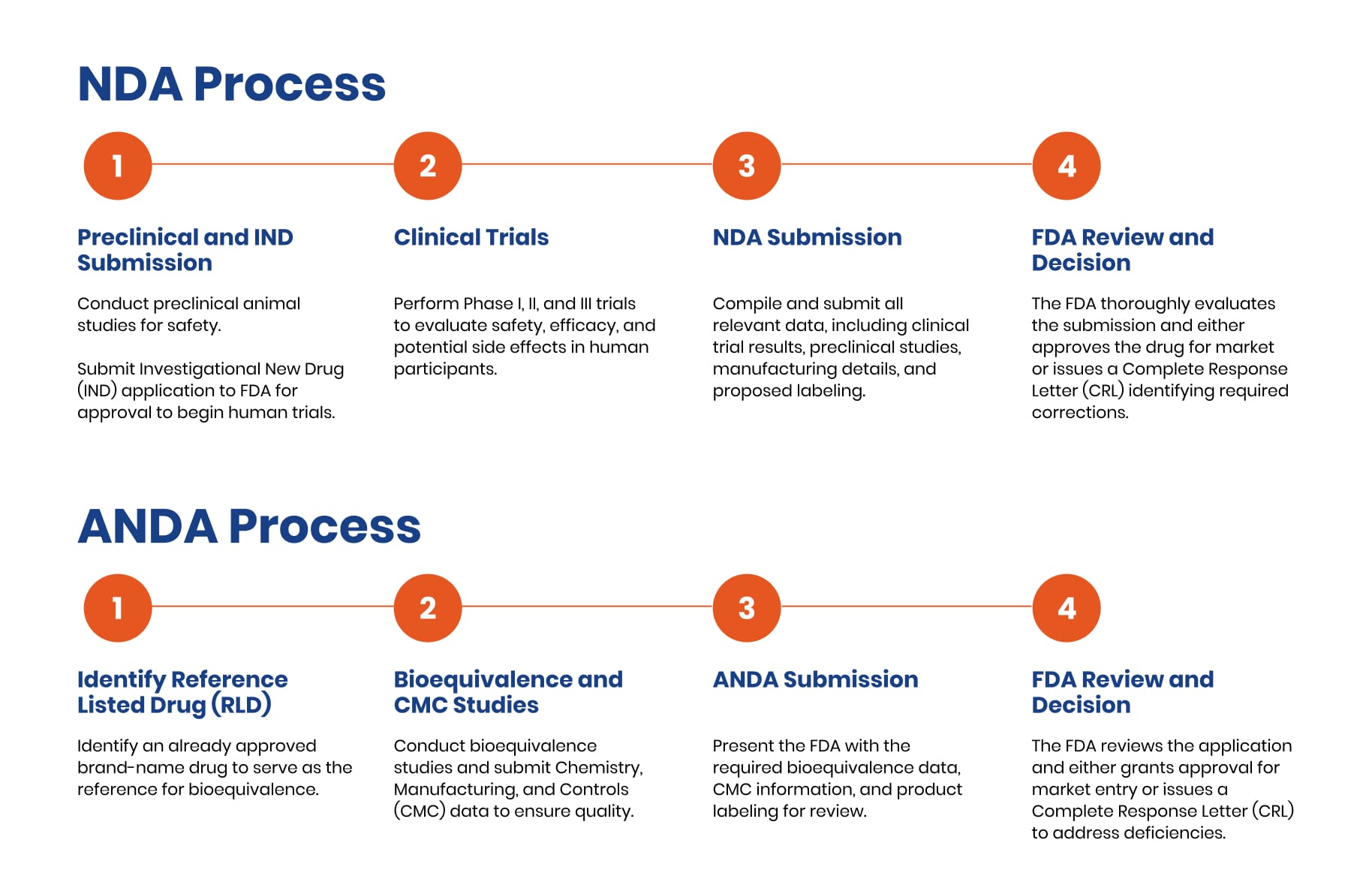The pharmaceutical landscape is governed by strict regulatory frameworks that focuses the safety and efficacy of medications. In the United States, two primary pathways exist for drug approval: the New Drug Application (NDA) and the Abbreviated New Drug Application (ANDA).
Understanding the distinctions between these processes is crucial for pharmaceutical companies and healthcare professionals. This guide explores the key differences, processes, and requirements of NDAs and ANDAs, providing a comprehensive overview of how new and generic drugs reach the market.

Exploring NDA
An NDA is a pivotal component of the drug approval process in the United States, serving as the formal mechanism through which pharmaceutical companies seek the FDA’s authorization to market a new pharmaceutical product. The NDA is comprehensive, encompassing all aspects of the drug’s development, including its safety and efficacy profiles, manufacturing processes, and proposed labeling.
The primary objective of the NDA is to provide the FDA with sufficient evidence to evaluate whether the new drug meets the necessary standards for safety, efficacy, and quality. Demonstrating safety and efficacy is paramount, as the drug’s benefits outweigh its risks for the intended patient population. The NDA process is a rigorous evaluation designed to protect public health by ensuring that only safe and effective medications reach the market.
Essential Components of an NDA Submission
An NDA submission is a detailed and multifaceted document that includes several critical components:
- Clinical Trial Data and Results: This section contains the results of all clinical trials conducted on the drug, including data from Phase I, II, and III trials. These trials assess the drug’s pharmacokinetics, pharmacodynamics, efficacy, and safety in human subjects. The data must demonstrate that the drug is effective for its intended use and has an acceptable safety profile.
- Preclinical Studies and Toxicology Reports: Before clinical trials begin, extensive preclinical studies are conducted to evaluate the drug’s safety in animal models. These studies help identify potential toxic effects and determine safe starting doses for human trials. The NDA includes all relevant toxicology data, including studies on carcinogenicity, genotoxicity, and reproductive toxicity.
- Manufacturing Information and Quality Control: The NDA must provide detailed information on the drug’s manufacturing process, including the facilities where the drug is produced, the methods used to for consistent product quality, and the procedures for testing the drug’s purity, potency, and stability.
Related Article: What is Pharmacodynamics?
The NDA Review Process
The FDA review process for an NDA is thorough and multifaceted, involving multiple steps and specialized review teams. The process begins with a preliminary evaluation of the application’s completeness, followed by an in-depth review by the FDA’s multidisciplinary team of experts.
Key steps in the FDA review process include:
- Filing Review: The FDA determines whether the NDA is sufficiently complete to permit a substantive review. If the application is incomplete, the FDA may issue a Refuse to File (RTF) letter outlining the deficiencies.
- Substantive Review: The FDA evaluates the scientific data and information in the NDA, focusing on the drug’s safety, efficacy, and quality. This review may involve consultations with external experts and advisory committees.
- Labeling and Risk Management: The FDA reviews the proposed labeling for accurate reflection of the drug’s benefits and risks. The agency also evaluates any proposed risk management strategies, such as a Risk Evaluation and Mitigation Strategy (REMS), to mitigate potential safety concerns.
- Decision Making: The FDA concludes the review process by making a final decision on the NDA. Possible outcomes include approval, issuance of a Complete Response Letter (CRL) outlining deficiencies that must be addressed, or a request for additional data. In some cases, the FDA may convene an advisory committee to provide recommendations.
How is ANDA Different?
An ANDA is a pathway designed for the approval of generic drugs. Unlike an NDA, which is used for new, innovative drugs, an ANDA does not require the submission of preclinical and clinical data to establish safety and efficacy.
Instead, it relies on demonstrating that the generic drug is bioequivalent to a previously approved brand-name drug, known as the Reference Listed Drug (RLD). This approach facilitates the entry of lower-cost alternatives into the market, increasing accessibility and reducing healthcare costs.
The primary goal of an ANDA is to establish that the generic product is therapeutically equivalent to the RLD. This means the generic must contain the same active ingredients, in the same strength and dosage form, and must deliver the same therapeutic effect. Bioequivalence is a critical aspect of this determination, as it makes sure that the generic and brand-name drugs perform similarly in the body.
Elements of an ANDA Submission
An ANDA submission focuses on several key components that collectively demonstrate the generic drug’s equivalence to the RLD:
- Bioequivalence Studies and Requirements: Bioequivalence studies are the cornerstone of an ANDA submission. These studies compare the pharmacokinetic properties of the generic drug to those of the RLD, specifically measuring parameters such as the rate and extent of absorption. To be considered bioequivalent, the generic drug must fall within an acceptable range of variability compared to the RLD, ensuring no significant differences in safety or efficacy.
- Reference Listed Drug (RLD) Considerations: The ANDA must identify a specific RLD that has already been approved by the FDA. The generic applicant must demonstrate that their product is comparable to this RLD in terms of active ingredients, dosage form, strength, route of administration, and conditions of use.
- Chemistry, Manufacturing, and Controls (CMC) Data: The ANDA must include detailed information on the chemistry, manufacturing, and controls of the generic drug. This includes the formulation and specifications of the drug substance and product, the manufacturing process, quality control measures, and stability data. The CMC data makes sure that the generic product can be consistently produced and meet the same quality standards as the RLD.
The ANDA Review Process
The FDA’s review process for ANDAs is designed to be efficient, reflecting the lower risk associated with generic drugs compared to new, innovative drugs.
The review process begins with a filing review to determine if the application is sufficiently complete. If the application meets the requirements, the FDA proceeds with a detailed assessment of the bioequivalence studies, CMC data development, and other relevant information. The agency may request additional information or clarifications during the review process.
The review timeline for ANDAs is typically shorter than for NDAs, reflecting the reduced need for clinical and preclinical data. The Generic Drug User Fee Amendments (GDUFA) program sets goals for the timely review of ANDAs, with standard reviews generally completed within ten months and priority reviews within eight months.
After completing the review, the FDA may approve the ANDA, allowing the generic product to enter the market. Alternatively, the FDA may issue a Complete Response Letter (CRL) if deficiencies are found. The approval of an ANDA has significant implications for the market, as it introduces competition, typically resulting in lower prices for patients and healthcare systems.

Comparing NDA and ANDA
When comparing NDAs and ANDAs, it is essential to understand the key differences in data requirements, cost and time considerations, and the implications of market exclusivity and patent issues.
Data Requirements and Evidence
NDAs necessitate comprehensive clinical data demonstrating the safety and efficacy of a new drug. This includes extensive clinical trials and preclinical studies.
In contrast, ANDAs focus on bioequivalence data, requiring evidence that the generic product performs similarly to the Reference Listed Drug (RLD) in terms of absorption and effect. This streamlined approach eliminates the need for costly and time-consuming clinical trials, provided the generic meets the bioequivalence criteria.
Cost and Time Considerations
The financial and time investments for NDA and ANDA applicants differ significantly. NDAs involve high costs and long timelines due to the need for extensive research and clinical trials, which can span several years.
ANDAs are less costly and quicker to develop as they bypass the clinical trial phase, focusing solely on demonstrating bioequivalence. This efficiency often results in a faster path to market, allowing generic drugs to be introduced more rapidly.
Market Exclusivity and Patent Issues
NDAs typically offer a period of market exclusivity, granting the innovator company exclusive rights to market the drug for a specified time, usually five years. This exclusivity period can be extended for pediatric studies or new clinical indications.
On the other hand, ANDA applicants may face patent challenges, including potential litigation, if they seek approval before the expiration of the RLD’s patents. Successful ANDA applicants can benefit from 180 days of exclusivity if they are the first to file, allowing them a temporary monopoly before other generics enter the market.
Navigating the Pharmaceutical Approval Maze
The NDA and ANDA processes are fundamental to the pharmaceutical industry. While NDAs are essential for introducing new, innovative therapies, ANDAs provide a pathway for affordable generic alternatives so patients have access to essential medicines.
As advancements in drug development continue, these processes will remain integral to maintaining the balance between innovation and accessibility.

